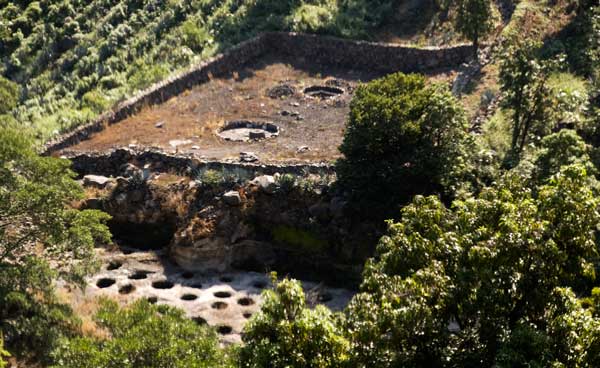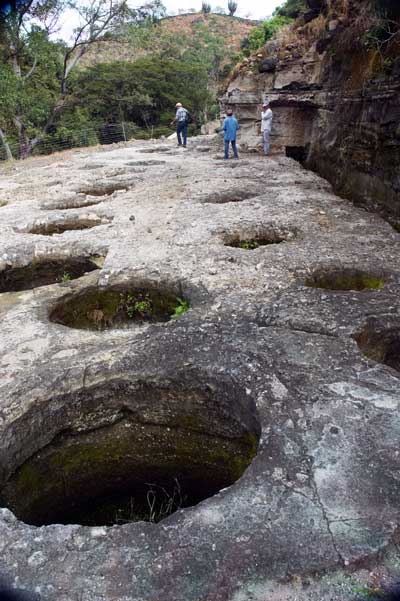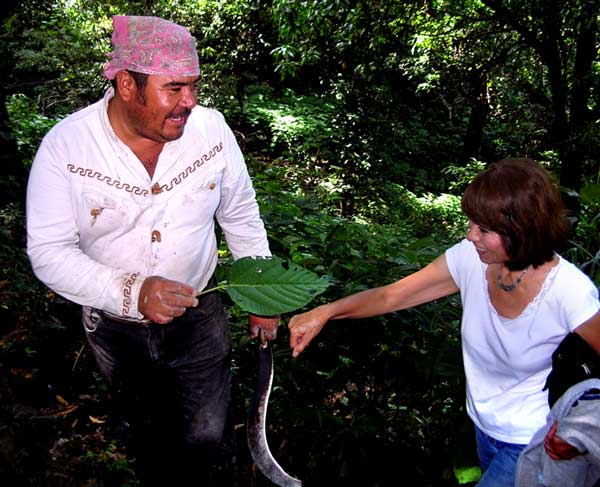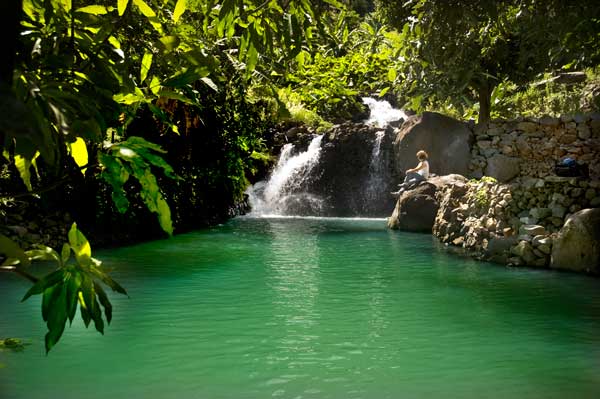
Hunting for the Birthplace of Tequila
Ancient Workings and Heavenly Pools in Tecuane Canyon
©2010 by John Pint


Part of the old workings of El Tecuane Distillery, built in the early 1700s and
possibly the oldest tequila factory anywhere. The area for cooking and grinding
the agaves can be seen above, and below are 44 fermentation pots carved into the
living rock.
Here, on a wide, flat spot, we peered down into the kind of oven used by the Indians to cook agave hearts before the Spaniards arrived. This is a deep pit lined with volcanic rocks. The Indians threw a mixture of agaves and red-hot rocks into the pit and covered it up. The cooked mezcal was then ground up using a people-powered millstone. The sweet juice trickled downhill to a lower mesa in which 44 fermentation pots were carved into the living rock. Each of these held about 3000 liters. The resulting alcoholic brew was then carried further downhill in buckets, to several stills, cooled by cold water channeled from a nearby spring.
|
Most sources say the technique of distillation was brought to the new world
by the Spaniards, but Don Rosario insisted the Indians had their own stills,
in which the steam condensed in cloths hanging above a pot of boiling
alcohol. “They wrung out these cloths and distilled that alcohol a second
time,” and one taste of this potent “vino mezcal,” as it was first known,
was, supposedly, what got the Spaniards into the tequila business. This claim is backed up by the owner of Santa Rita, tequila historian Miguel Claudio Jiménez Vizcarra, who quotes from Domingo Lázaro de Arregui’s 1621 Description of New Galicia: “The Mexcales are much like the maguey. Their root and the base of their spikes are roasted and eaten. In addition, when they are pressed, they exude a must, from which a liquor is distilled, clearer than water, stronger than aguardiente and of such good taste.”
|
 |
Whether the native Mexicans had developed their own stills, I can’t say, but
standing in the middle of 44 huge old fermentation pots carved out of rock, I
was definitely convinced that those Amatitán Indians (Tecuane was considered
part of Amatitán) were no amateurs when it came to alcoholic beverages.
A bit dazed after visiting the incredible Tecuane tequila workings, we headed
back up the hill to the balneario to enquire about the Pools of Paradise.
Alas, the balneario has a rather seedy looking cement swimming pool filled with
dirty water, which on Sundays is said to be jammed with people who come to enjoy
a swim and a fish fry. This was obviously not the “natural, spring-fed pool” we
were looking for, but the owner of the balneario, Señor Ricardo Ramirez
immediately understood what we were talking about. “The pools you seek are the
source of the water I use in my fish farm,” he explained, indicating a row of
huge tanks in the distance, each one brimming with mojarras. “Would you like to
take a look? There’s a path that leads from here right to the pools.”
|
I should have suspected what sort of path it was when Ricardo grabbed a machete and started swinging it. A few minutes later we were tiptoeing along the top of the slime-covered side wall of a channel filled with rushing water. “Watch out for that plant,” warned Ricardo. “We call that one La Quemadora (The Burner). It stings like crazy but you mustn’t scratch it. You just have to aguantar (endure the pain) for a minute or two and then it’s all over.” We also had to “aguantar” a rather long hike along the steep non-path until, dripping with sweat and covered with clinging plant parts and burrs, we arrived at Paradise.
|
 |
There were two glorious pools surrounded by banana plants, mamey trees and rich
jungly growth, with a couple of picturesque waterfalls thrown in for good
measure. Colorful chachalaca birds frolicked overhead and…well, I’d better not
go on because this little paradise is on the land of someone who wants no
visitors, having been “burned” again and again by people who leave the place
strewn with garbage and worse. Oh well, I guess it’s in the nature of Paradise
to be of difficult access, isn’t it?

Susy Pint Meditating at the Paradise Pool
By the way, when we mentioned to Ricardo that the blue agave is supposed to have originated in Santa Rosa Canyon, he corrected us. “No, that’s not true,” he said. “The blue tequila agave actually comes from this very valley, right here.” Something tells me we have not heard the last of El Tecuane.
Watch a three-minute
video
of El Tecuane on Youtube.
How to get there
Drive west out Guadalajara toward Nogales. When you reach the town of Amatitán,
turn right just before the first overhead footbridge across the highway. Take
this road, signposted “El Salvador,” four kilometers north. Turn right at the
Tecuane Balneario sign. Whenever you see forks or turnoffs, stick to the main
cobblestone road. After only one kilometer you will come to the magnificent
canyon view. Three kilometers from the El Salvador road, you come to the only
major fork in this itinerary. Bear right. After one more kilometer you’ll be at
the Santa Rita Distillery and just below, the ruins of Taberna Tecuane. Driving
time from the Guadalajara Periférico to the old tequila workings: just over one
hour.
